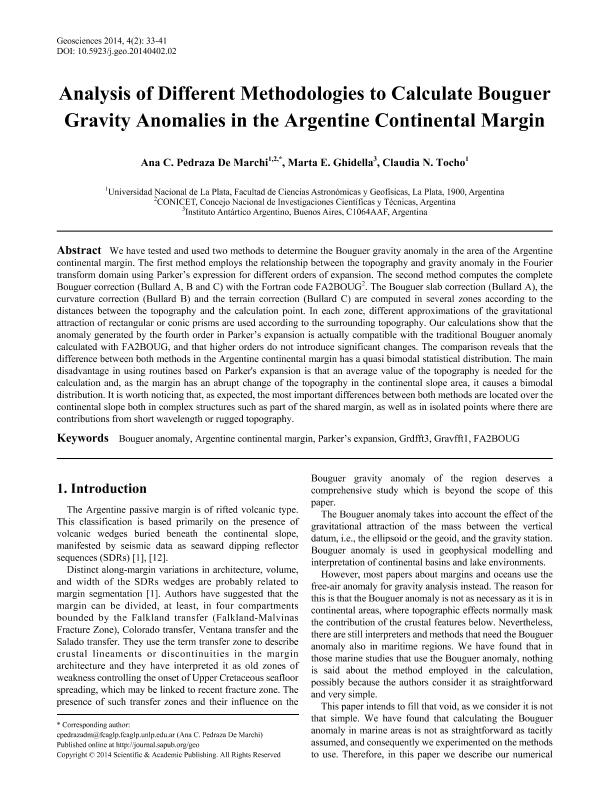Mostrar el registro sencillo del ítem
dc.contributor.author
Pedraza de Marchi, Ana Carolina

dc.contributor.author
Ghidella, Marta E.
dc.contributor.author
Tocho, Claudia

dc.date.available
2018-01-10T14:13:47Z
dc.date.issued
2014-04
dc.identifier.citation
Tocho, Claudia; Ghidella, Marta E.; Pedraza de Marchi, Ana Carolina; Analysis of Different Methodologies to Calculate Bouguer Gravity Anomalies in the Argentine Continental Margin; Scientific & Academic Publishing; Geosciences; 4; 2; 4-2014; 33-41
dc.identifier.issn
2163-1697
dc.identifier.uri
http://hdl.handle.net/11336/32781
dc.description.abstract
We have tested and used two methods to determine the Bouguer gravity anomaly in the area of the Argentine continental margin. The first method employs the relationship between the topography and gravity anomaly in the Fourier transform domain using Parker’s expression for different orders of expansion. The second method computes the complete Bouguer correction (Bullard A, B and C) with the Fortran code FA2BOUG2. The Bouguer slab correction (Bullard A), the curvature correction (Bullard B) and the terrain correction (Bullard C) are computed in several zones according to thedistances between the topography and the calculation point. In each zone, different approximations of the gravitationalattraction of rectangular or conic prisms are used according to the surrounding topography. Our calculations show that the anomaly generated by the fourth order in Parker’s expansion is actually compatible with the traditional Bouguer anomaly calculated with FA2BOUG, and that higher orders do not introduce significant changes. The comparison reveals that the difference between both methods in the Argentine continental margin has a quasi bimodal statistical distribution. The main disadvantage in using routines based on Parker's expansion is that an average value of the topography is needed for the calculation and, as the margin has an abrupt change of the topography in the continental slope area, it causes a bimodal distribution. It is worth noticing that, as expected, the most important differences between both methods are located over the continental slope both in complex structures such as part of the shared margin, as well as in isolated points where there are contributions from short wavelength or rugged topography.
dc.format
application/pdf
dc.language.iso
eng
dc.publisher
Scientific & Academic Publishing
dc.rights
info:eu-repo/semantics/openAccess
dc.rights.uri
https://creativecommons.org/licenses/by-nc-sa/2.5/ar/
dc.subject
Bouguer Anomaly
dc.subject
Argentine Continental Margin
dc.subject
Parker’S Expansion
dc.subject
Grdfft3
dc.subject
Gravfft1
dc.subject
Fa2boug
dc.subject.classification
Meteorología y Ciencias Atmosféricas

dc.subject.classification
Ciencias de la Tierra y relacionadas con el Medio Ambiente

dc.subject.classification
CIENCIAS NATURALES Y EXACTAS

dc.title
Analysis of Different Methodologies to Calculate Bouguer Gravity Anomalies in the Argentine Continental Margin
dc.type
info:eu-repo/semantics/article
dc.type
info:ar-repo/semantics/artículo
dc.type
info:eu-repo/semantics/publishedVersion
dc.date.updated
2017-12-26T14:31:35Z
dc.journal.volume
4
dc.journal.number
2
dc.journal.pagination
33-41
dc.journal.pais
Estados Unidos

dc.description.fil
Fil: Pedraza de Marchi, Ana Carolina. Consejo Nacional de Investigaciones Científicas y Técnicas; Argentina. Universidad Nacional de la Plata. Facultad de Ciencias Astronómicas y Geofísicas; Argentina
dc.description.fil
Fil: Ghidella, Marta E.. Ministerio de Relaciones Exteriores, Comercio Interno y Culto. Dirección Nacional del Antártico. Instituto Antártico Argentino; Argentina
dc.description.fil
Fil: Tocho, Claudia. Universidad Nacional de la Plata. Facultad de Ciencias Astronómicas y Geofísicas; Argentina
dc.journal.title
Geosciences
dc.relation.alternativeid
info:eu-repo/semantics/altIdentifier/url/http://article.sapub.org/10.5923.j.geo.20140402.02.html
dc.relation.alternativeid
info:eu-repo/semantics/altIdentifier/doi/http://dx.doi.org/10.5923/j.geo.20140402.02
Archivos asociados
